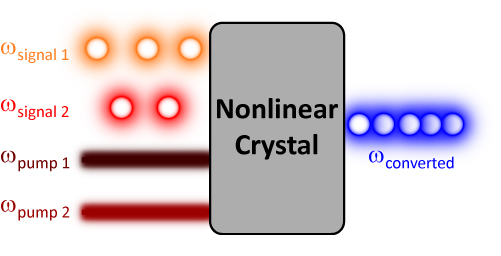Researchers at NIST Center for Nanoscale Science and Technology were able to make photons emitted by quantum dots at different frequencies identical to each other by shifting their frequencies to match*. This promises the beginning of making solid-state, single photon sources, including quantum dots, more useful light sources for photonic quantum information science.
The reason why quantum dot sources are so important is because of their high brightness, stability, and amenability to scalable fabrication technology. However due to frequency variations arising from nonuniform device fabrication it has limited their usefulness.
In the past researcher have focused on tuning the sources themselves, by inducing strain or by varying the electrical and optical fields surrounding the structures. With the new approach the team was able to manipulate the photons after they are generated, rather than altering the sources.

The quantum frequency conversion method uses two pump lasers whose frequency difference is matched to the difference between the two input photon streams, causing the new photons from a nonlinear crystal to be emitted at exactly the same frequency (Courtesy of NIST).
For their test, the researchers used photons emitted from a semiconductor quantum dot at two different frequencies which are determined by two of the dot’s different energy states. They were able to show that the photons can be converted to the same frequency, or color, using quantum frequency conversion, a process in which each a single photon stream is combined with light from a much stronger pump laser in a nonlinear crystal which outputs photons at a frequency that is the sum of the two inputs.
As shown in the image above, two pump lasers are used, with the frequency difference between them set to match the difference between the two input photon streams, causing the new photons to be at exactly the same frequency. The team used an interference measurement to confirm that the frequency-converted photons have become identical. Because this method uses relatively large nonlinear crystals for frequency conversion, future work will focus on implementing the conversion method in smaller and more scalable device architectures. This research is noted in the October 5, 2012 issue of
Physical Review Letters [“Two-photon interference using background-free quantum frequency conversion of single photons emitted by an InAs quantum dot,” S. Ates, I. Agha, A. Gulinatti, I. Rech, M. T. Rakher, A. Badolato, and K. Srinivasan, Physical Review Letters 109, 147405 (2012)] and also reported in the Novemebr issue of Physics Today. For additional information contact Kartik Srinivasan at 301-975-5938.and also reported in the Novemebr issue of Physics Today . For additional information, contact Kartik Srinivasan at 301-975-5938.
Advertisement
Learn more about National Institute of Standards and Technology





